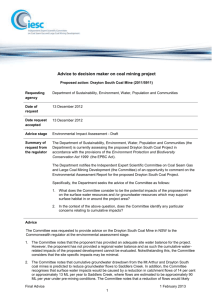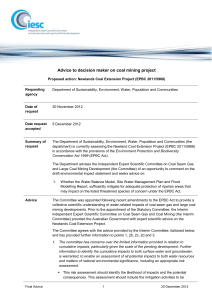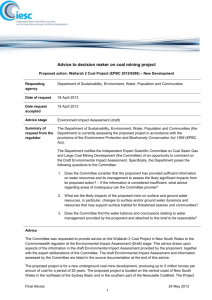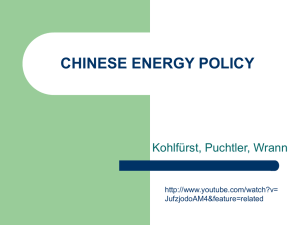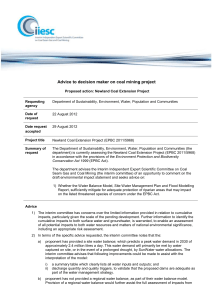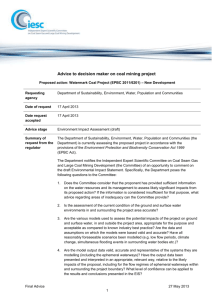The Range Project advice (DOCX - 100.37 KB)
advertisement
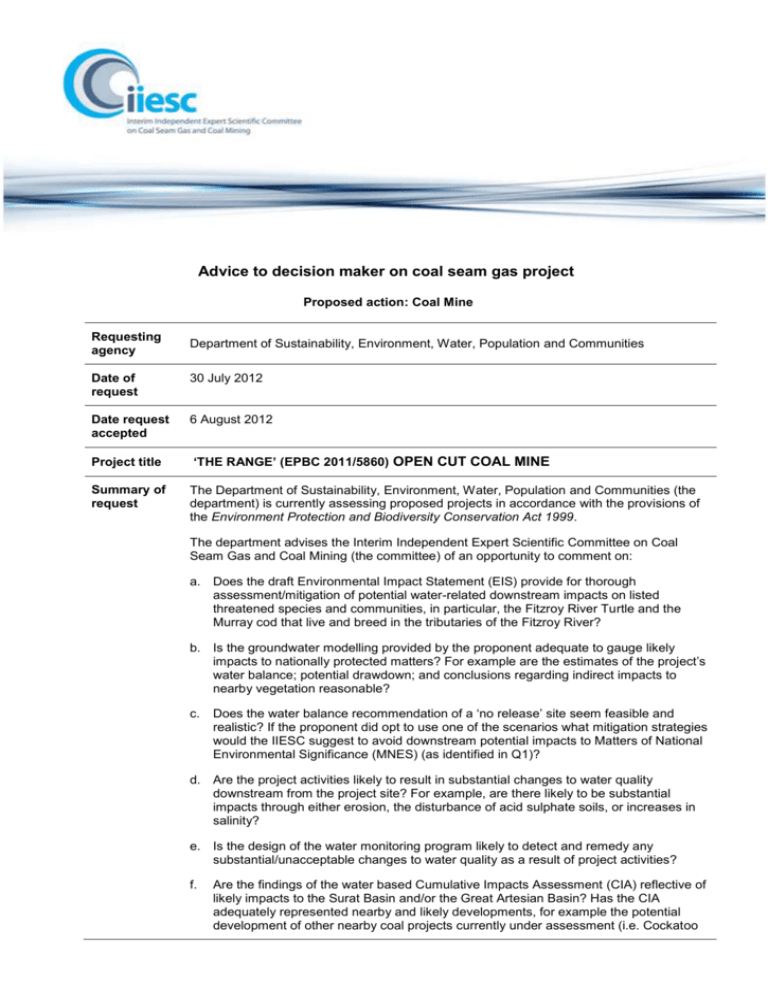
Advice to decision maker on coal seam gas project Proposed action: Coal Mine Requesting agency Department of Sustainability, Environment, Water, Population and Communities Date of request 30 July 2012 Date request accepted 6 August 2012 Project title ‘THE RANGE’ (EPBC 2011/5860) OPEN CUT COAL MINE Summary of request The Department of Sustainability, Environment, Water, Population and Communities (the department) is currently assessing proposed projects in accordance with the provisions of the Environment Protection and Biodiversity Conservation Act 1999. The department advises the Interim Independent Expert Scientific Committee on Coal Seam Gas and Coal Mining (the committee) of an opportunity to comment on: a. Does the draft Environmental Impact Statement (EIS) provide for thorough assessment/mitigation of potential water-related downstream impacts on listed threatened species and communities, in particular, the Fitzroy River Turtle and the Murray cod that live and breed in the tributaries of the Fitzroy River? b. Is the groundwater modelling provided by the proponent adequate to gauge likely impacts to nationally protected matters? For example are the estimates of the project’s water balance; potential drawdown; and conclusions regarding indirect impacts to nearby vegetation reasonable? c. Does the water balance recommendation of a ‘no release’ site seem feasible and realistic? If the proponent did opt to use one of the scenarios what mitigation strategies would the IIESC suggest to avoid downstream potential impacts to Matters of National Environmental Significance (MNES) (as identified in Q1)? d. Are the project activities likely to result in substantial changes to water quality downstream from the project site? For example, are there likely to be substantial impacts through either erosion, the disturbance of acid sulphate soils, or increases in salinity? e. Is the design of the water monitoring program likely to detect and remedy any substantial/unacceptable changes to water quality as a result of project activities? f. Are the findings of the water based Cumulative Impacts Assessment (CIA) reflective of likely impacts to the Surat Basin and/or the Great Artesian Basin? Has the CIA adequately represented nearby and likely developments, for example the potential development of other nearby coal projects currently under assessment (i.e. Cockatoo Coal’s Taroom and Collingwood mines)? g. Is the design of the dams, including the tailings storage facility, sufficient to prevent seepage and minimise loss of dam site water (ensuring any potential downstream impacts to MNES are adequately protected)? Advice 1. In terms of downstream impacts, the committee notes that no matters of national environmental significance were recorded in the study area during the survey period. However, the committee considers that the environmental impact statement did not provide for a thorough assessment of potential indirect impacts to matters of national environmental significance. For example, the assessment of cumulative impacts appears spatially limited (i.e. restricted to a small number of projects) and the aquatic survey methodology undertaken appears temporally limited (i.e. no provision for seasonal variation). 2. Despite limitations in the cumulative assessment, the committee notes that the assessment identified potential high risks to surface water and that the contributions of these impacts, including their contribution to indirect impacts (e.g. downstream impacts) on potential matters of national environmental significance, do not appear to have been investigated by the proponent. 3. In terms of impacts to groundwater, the committee notes that impacts were investigated through the development of a hydrogeological model for the project area, including the open pit area, transport corridor and rail loading facility. The committee considers that given the scale of the Range proposal, the hydrogeological model appears appropriate and adequate. However, although the Range project’s groundwater impacts will be insignificant when compared to other larger scale projects, the committee considers that the Range project will contribute to cumulative impacts in the region. 4. Although the project is intended to be operated as a “no release” site, the committee considers that water quality may be adversely affected by discharges of high salinity concentrations. There are a number of proposed discharge options which may be used, as dam storage designs are between a 20 and 100 year Average Recurrence Interval (ARI) event. The committee notes that the proponent’s preferred option is to release excess water which would result in a dilution ratio of 1:7, which is required for adequate release. This dilution ratio is above the recommended 1:4 for coal mines in the Fitzroy Basin. The committee further notes that the proponent is required to seek approval for higher release rates. Related potential impacts to water quality from potential discharges, including erosion, do not appear to have been discussed. 5. The committee considers that water quality may also be affected by discharges from a second mine water system, located at the rail loop where product will be stored. The runoff dam is likely to be hazardous and require a design storage allowance. In addition, water quality may be further impacted by acid sulphate soils. The committee considers that although overburden is classified as non-acid forming, water quality may be impacted, especially if water from the final void discharges into water courses. Further information regarding void decant potential is required to undertake an adequate assessment. 6. The committee considers that further mitigation measures are required for matters of national environmental significance. For example, the proponent could be required to establish an adequate baseline data set for both water quality and aquatic species attributes that demonstrates multi-year diversity. A further assessment could also be undertaken on the cumulative impacts and possible mitigation measures in response to those impacts. 7. The committee notes that the water monitoring program includes turbidity monitoring during construction of the creek crossing, compliance monitoring against water quality objectives, and a receiving environment monitoring program. Largely the proposed monitoring strategies appear adequate. However, the proponent states as part of the receiving environment monitoring program that as the site has a “no release” strategy, further monitoring of creeks may not be required once the background values have been established. The committee considers this approach inadequate, as monitoring should be undertaken over the life of the project. 8. The department has advised that cumulative assessments would only be undertaken, as proposed by the proponent, for key impacts determined ‘high’ or ‘very high’ as described in table 31-4 (EIS, Chapter 31, page 31-17) and that the scenario of ‘no water release’ was not included in the cumulative impact 2 assessment. The committee notes those findings and further advises that the consideration of projects as part of the cumulative impact assessment was restricted to the Xstrata Wandoan coal project and the Arrow coal seam gas project. The committee also notes that impacts on the Great Artesian Basin do not appear to have been discussed. 9. The committee considers that water quality may be impacted by seepage from the tailings storage. However, the committee notes that the proponent has not provided specific modelling to indicate the quantity of seepage; it is noted that seepage will be alkaline (maximum pH 10) and have low to moderate salinity (maximum 700 µs/cm). It is considered that seepage quality may also fluctuate, as it will be affected by the quality of the contained water. As discussed above, water quality may be further affected by discharges, which are likely to require dam storage designs between a 20 and 100 year ARI event, and potential void decant. Date of advice 10 September 2012 3
